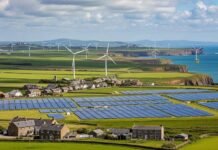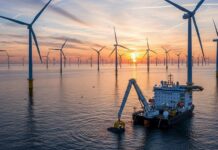The foundations of the modern world happen to have been laid by one major event called the industrial revolution. Profusion when it comes to new technologies and manufacturing processes, teamed with innovations in finance and entrepreneurship, went on to create a staggering growth in firms’ productivity as well as the wealth and capabilities of organized society.
However, as the economies have grown, industrial energy demand along with pollutant emissions have increased, thereby limiting the progress one can achieve by way of using dirty technologies of today.
Currently, one stands on the cusp of yet another great change, and that’s the clean industrial revolution. Manufacturers happen to be switching to cleaner, more efficient processes like electrified industrial heat as well as hydrogen-based steelmaking. Industrial firms all throughout the world stand to profit from the varied new technologies coming online.
A shift to a zero-carbon industry happens to be starting, and it will change the way one goes on to make everything.
This is indeed the core message of the Zero-Carbon Industry, a new guide to the breakthrough technologies transitioning the manufacturing sector and the policies that can speed up the worldwide transition to clean industry.
Flagbearers of Change
Industrial firms go on to produce the materials as well as finished products one relies on in all aspects of life. This level of productivity needs a vast quantity of energy. For example, in 2022, the industrial backdrop was responsible for 35% of the US’ energy consumption. Hence, how manufacturers use energy happens to have enormous implications for the worldwide economy and emissions.
There happens to be a growing interest in making a switch to clean industrial processes. In part, this is being throttled by policies that look forward to slashing industrial pollution, like the European Union’s carbon border alteration mechanism, which is going to charge a fee on products that are made by way of using dirty and inefficient technologies.
It happens to be also driven by companies’ aspiration to be technological leaders and, at the same time, capitalize on new funding options for clean, innovative manufacturing procedures like the U.S. Advanced Industrial Facilities Deployment Program, state and federal initiatives, and the Advanced Energy Project Credit, so as to buy low-emission industrial products.
The Top-Emitting Sectors
Across the world, more than 60% of industrial carbon dioxide emissions happen to come from three elements- chemicals, iron and steel, and non-metallic minerals, mostly cement.
It is well to be noted that today’s primary or non-recycled steel happens to be made by heating iron ore in a blast furnace fueled by using coal and coke, which happens to be a coal-derived fuel. Due to this, iron and steelmaking happens to be responsible for 7% of international CO2 emissions, which is more than the emissions from all freight trucks put together. But companies happen to be developing new steel production pathways.
For instance, three Swedish firms went on to establish the HYBRIT consortium in order to produce steel by way of using hydrogen that is made from renewable electricity. Over a dozen facilities across Europe, such as those owned by the two largest European steelmakers, ArcelorMittal as well as ThyssenKrupp, happen to be in various stages of embracing this technology. A number of start-ups, like Boston Metal as well as Electra, are going ahead and developing other new ways to make steel that is, in all senses, clean, directly from electricity as well as iron ore.
It is worth noting that the innovation story happens to be similar for cement as well as chemicals. Today, cement happens to be made by decomposing limestone in a rotating kiln that is heated by coal. Cementa, which is a subsidiary of the world’s second-largest cement maker, Heidelberg Materials, went on to discover how to heat a cement kiln by way of using electricity and also capture the CO2 emissions from limestone.
Meanwhile, technologies like electrified heat, enhanced catalysts, and hydrogen- or bio-based input materials go on to offer high-tech routes to make fertilizers, plastics, as well as other chemical products sans fossil fuels.
Technologies for All Manufacturers
The fact is that heavy industries are not the only businesses that are being transformed. New, cross-cutting technologies are going to be relevant to every manufacturer, be it large or small. For example, many industries go on to rely on heat up to almost 330 °F or 165 °C for processes like cooking food, driving chemical reactions, bleaching paper, and treating metal and wood.
These temperatures can be touched by an industrial heat pump, which is a machine that moves heat from one place to another, just like a refrigerator or air conditioner. Since heat pumps only go on to move heat in place of creating it, they can be more efficient as compared to fuel combustion or other electrical technologies. Heat pumps happen to be used in plants producing Nestlé chocolate as well as powdered milk, painting automobiles, electroplating metal parts, as well as brewing beer.
Apparently, other exciting opportunities for manufacturers go on to include fresh ways to boost energy as well as material efficiency, enhance products’ longevity and repairability, create electrified heat and also store it in thermal batteries, make use of clean hydrogen, which is facilitated by government efforts like the U.S.’s Regional Clean Hydrogen Hubs or Germany’s Clean Hydrogen Coastline project, as well as capture and store carbon underground.
Policies so as to support a Zero-Carbon industry transformation
Technologies are critical to the shift to a clean industry; however, they are only part of the picture.
It is well to be noted that enacting the right policies can go on to spur investment, promote industrial technology leadership, and, at the same time, hasten pollution reductions. Financial incentives, low-cost loan access, and carbon pricing can go on to level the playing field for new technologies that happen to be competing against incumbent, dirty technologies that do not pay when it comes to harms caused by their pollution. Well-designed energy efficiency or emissions benchmarks, apparently, can drive long-term technological enhancements in industrial equipment while also ensuring industries always get access to affordable, commercialized technology that goes on to meet the standard.
Notably, government support for research and development has been significant in the development of countless technologies that one relies on today, such as the internet, GPS, numerous drugs and medical devices, AI, light-emitting diodes- LEDs, solar panels, etc. They can again play a major role in speeding up technological growth by way of research in national laboratories, coming up with a research consortium, investing in contract research, helping firms’ access to science as well as engineering talent, and also fixing flaws in the patent system.
Smart policy can go on to make sure that the coming shift in industry does not go on to worsen inequality or leave vulnerable communities behind. Industrial firms happen to be major employers in their cities as well as towns, so it is important to safeguard jobs across these communities, even as fresh facilities go on to bring jobs to communities that happen to be in need.
In order to do this, governments can go on to offer retooling grants so as to help manufacturers upgrade their equipment, offer incentives to firms that go ahead and ink local hire agreements, and at the same time support local infrastructure investment. In addition to this, they can as well purchase products like materials for public buildings as well as roads from companies that go on to achieve high labor standards, make sure to pay fair wages, and also offer community perks.
The economic opportunities happen to be vast, and they are indeed driven by innovative research and public policy that make investment in efficient industrial technology more beneficial than ever before. The clean industrial revolution is currently taking place, and business leaders, investors, as well as policymakers must go on to seize the choices that lie ahead when it comes to the global shift to a zero-carbon sector.

































